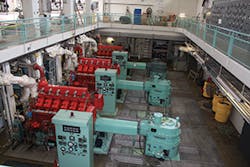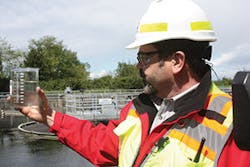Alarms blinked and buzzed right and left as a perfect storm hit the Seattle West Point wastewater treatment plant on the night of February 8–9, 2017.
That storm consisted of roughly 1.5 inches of rainfall, more than 300 million gallons of mostly stormwater mixed with sewage, and electrical glitches at Seattle’s main treatment plant, knocking it offline, flooding it, and spilling 180 million gallons of untreated wastewater—90% stormwater and 10% raw sewage—into nearby Puget Sound over the next 19 hours.
The King County Wastewater Treatment Division took almost 80 days to get the plant fully functional again, with some temporary fix-it measures still needing to be upgraded. Work slowed when heavy rains on February 15–16 sent another untreated 55 million gallons of stormwater and raw sewage—at the same 90% to 10% ratio—over 20 hours through the plant’s emergency bypass system directly into Puget Sound.
King County, of which Seattle is the county seat, has a combined sewer system that feeds everything—stormwater and sewage—into the county’s three wastewater treatment plants. The county plans to gradually upgrade to separate stormwater and wastewater collection and pipe systems by 2030.
West Point serves Seattle and its northern suburbs. During the winter rains, it usually handles 300 million gallons a day (mgd). In the drier summer months, the plant deals with about 90 mgd. It is designed to treat up to 440 mgd.
The repair price tag will likely be north of $25 million. The environmental damage was still being examined as this article was written. The Washington Department of Ecology had not yet decided as of May 1 whether or how much the plant would be fined for dumping untreated fluids into Puget Sound.
The main culprits appear to be a power outage of unknown origin, along with non-functioning floating switches in the plant’s primary treatment tanks. The loss of power was not related to Seattle’s excessive rains of early February—3.1 inches prior to February 8 and 1.5 inches on February 8–9—according to Tiffany Knapp, an engineer for the King County Wastewater Treatment Division. However, the deluge of stormwater into the wastewater treatment plant slowed the reactions of the facility’s nine night staff members so that they could not cope with the power outages fast enough to prevent the 52-year-old plant from an emergency shutdown.
Heavy rains on February 8 and early February 9 hit Seattle. Roughly 300 million gallons of stormwater and sewage went through the plant, but that was far less than the facility’s 440-million-gallon capacity. The plant should have handled the high volume of wastewater with ease.
But shortly after 2 a.m. on February 9, still-to-be-identified electrical problems shut down two of four pumps that would send the wastewater collected in tanks through the plant’s treatment processes and into Puget Sound. A few minutes later, the other two pumps shut down because of the strain of excessive vibrations caused by the first two pumps quitting.
The night shift’s nine operators tried to restart the pumps while keeping the increasing volumes of wastewater in the primary treatment tanks from going into the stalled pumps.
The tanks have a total of eight “float switches”—think of the rubber ball and rod inside a toilet tank that turns off the water as the tank refills. The floating switches’ purpose is to keep wastewater from flowing into the primary tanks once the switches float within a foot of the top of the tank. Those switches did not work that night, meaning the inflow became overflow and flooded the plant’s bottom-floor chambers. Twelve minutes elapsed between the pumps dying and the primary treatment plant beginning to overflow.
The flooding was too much, too fast, and too powerful for the operators to work in. The water chased the workers from the bottom floor that held the motors and pumps. Water filled the rooms and corridors to the top, meaning the water ranged from 9 to 13 feet deep in those chambers. Minor injuries occurred. Major injuries and deaths were avoided. “It was an instantaneous failure. It was the equivalent of two Olympic-size swimming pools every two minutes. It was pretty overwhelming,” says Knapp.
At roughly 3 a.m., the night shift managed to get some manual pumps functioning to send the wastewater into a bypass system leading to a point 3,600 feet beyond the Puget Sound shoreline.
Then a slow cleanup began, involving about 100 county workers. The floodwaters had to be drained. Motors, pumps, electrical panels, and pipe insulation had to be repaired or replaced. By February 21, about 95% of the cleanup and 50% of the electrical and mechanical fix-it work was done. But much of the work remained on removing water-damaged insulation from around the pipes. Workers finished restoring power on March 30. Although the plant became functional on April 30, it was expected to take more time before it could return to its full 440-million-gallon capacity.
The numbers for the repair work: cleaning up 1 mile’s worth of tunnels, fixing 51 electric motors, replacing 2 miles of insulation, replacing 125 electric panels, repairing or replacing 25 transformers, replacing 200 flooded solenoids and more than 1,000 lights, and fixing 1,200 outlets and switches. Part of the work included adding extra float switches and adding back ups to the power supplies.
“It’s been a long process of recovery,” says Robert Waddle, the plant’s operations and maintenance manager.
Robert Waddle holding a glass of water showing
the cleanliness of the effluent leaving the digesters
Meanwhile, the plant had to deal with the microbes that eat organic solids in its six digesters going dormant. These microbes are an important step in purifying wastewater before it is eventually pumped into Puget Sound. The microbes live and thrive in a delicate balance of food, heat, light, and air. They work best when their temperature remains at 98.6 degrees. But the plant’s shutdown dropped their watery habitats’ temperatures by 60 degrees.
New microbes were brought in from another King County treatment plant, and the watery digesters were gradually heated up, with sewage added to feed the reviving microbes—with care taken not to kill the microbes by resurrecting them too quickly. One example of the trickiness in getting the right mixtures is that a slightly “off” environment in the digesters causes foam, which had been a problem for the plant even before the February 9 emergency. The foam reduces the volume of water in the digesters, which reduces the speed of the microbes chomping on the biosolids. But the resulting effluent is still clean. “It’s a nuisance that we’re trying to figure out,” says Waddle.
During West Point’s restoration, the plant produced more biosolid waste than its digesters could handle. So the excess biosolids were trucked—13 to 22 truckloads a day—to a sister wastewater treatment plant in the Seattle suburb of Renton.
The final fix-it costs are unknown, although preliminary estimates came up with a $25 million price tag. “It’s safe to say the number will exceed that,” says Knapp. The county’s total insurance coverage is $250 million with a $250,000 deductible. Knapp says the insurance has paid for much of repair and replacement costs so far; it’s still undecided who will pay the remaining dollars.
While the repair work was underway, the county government and King County Council began trying to figure out what went wrong.
As of May 1, the plant’s staff, aided by CH2M Hill, had not figured out what caused the original power outage. However, the staff theorized that the float switches did not work because the rod portions were bent during routine maintenance. The Seattle Times reported that similar deficiencies were found in the float switches in 2000, 2004, and 2008.
On February 27, the King County Council unanimously voted to skip seeking competitive bids and told its staff to find an outside consultant to take an independent look at what went wrong. The decision to waive the competitive bidding process was intended to quickly pin down the causes and ensure all remedial work would be completed as soon as possible. Council member Rod Dembowski says, “It’s good to have an outside check.” Council member Jeanne Kohl-Welles adds, “This is so we can figure out why this happened.”
On April 27, the county council unanimously approved its staff’s recommendation to hire the multinational engineering firm of AECOM to have a report submitted by July 1 for a cost of $418,700. “We have worked at various types of disasters at treatment plants,” notes Donald Champenois, AECOM’s team leader for this project.
Champenois says each major failure at a treatment plant has its own unique set of circumstances; he declined got speculate on what might have happened at King County’s West Point plant. “We’ll be waiting with baited breath to hear what you have to report,” says Kohl-Welles to Champenois.
“We welcome that review coming in and taking place. We still have a lot of work to do,” says Christie True, director of the King County Department of Natural Resources and Parks.
Another question mark is the potential environmental damages to Puget Sound after the untreated wastewater was released three-quarters of a mile offshore. Puget Sound has orcas listed as federally endangered and salmon runs listed as federally threatened.
King County routinely monitors water quality at 12 offshore and 20 beach locations and maintains a database with information going back 50 years for many of those spots. The offshore stations check for dissolved oxygen, temperature, salinity, density, chlorophyll, and light intensity from surface to bottom. Also in some places, the stations collect information on nutrients, fecal indicator bacteria, suspended solids, and phytoplankton. Beach locations are monitored monthly for nutrients, fecal indicator bacteria, temperature, and salinity.
While the West Point plant was offline, the monthly checks were increased to weekly. Meanwhile, the state Department of Ecology loaned King County a Submersible Ultraviolet Nitrate Analyzer sensor to see whether nitrate levels increased.
The monitoring determined that fecal bacteria levels at all beach-monitoring stations were normal for April and were within state water-quality standards. Nutrient and nitrate levels—along with readings for most of the other monitored substances—were normal and within state standards in April. However, readings for biological oxygen demand and total suspended solids were abnormally high in March and April, and greater than what the state allows. A King County website notes that most pathogens die within 48 hours in cold salty marine water. And Knapp says the huge volume of Puget Sound has diluted the untreated wastewater that was dumped into it. “We haven’t seen any water-quality impacts or concerns,” she says.



